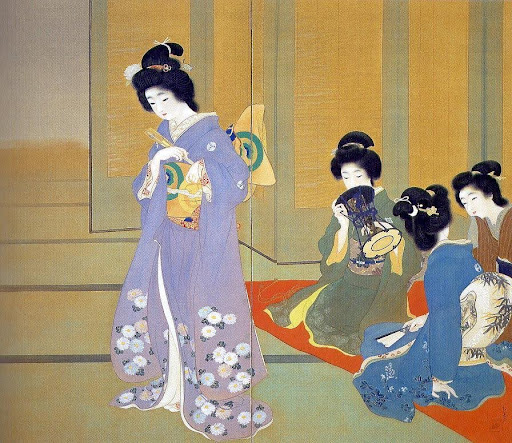4.舞支度(Mai Jitaku)
大正期の女性美と精神性の融合

《舞支度》は1914年に描かれた代表作のひとつで、舞を前にした女性たちの準備の様子を描いた二曲一隻の屏風作品。静謐な構図に宿る舞の気品を表現した。松園は、女性の美を「外見」ではなく「精神性」として捉え、舞の準備という日常の一瞬に高雅な美を見出した。着物の文様や髪型、表情の描写には細心の注意が払われ、古典的な美と近代的な感覚が融合している。中央の女性は、まだ十代と思われる若さを感じさせる顔立ちで、未来への希望と緊張が同居する瞬間を象徴している。第8回文展で二等賞を受賞し、松園の画業における重要な転機となった。近代日本画の傑作として高く評価されている。
Mai Jitaku (Preparing to Dance)
A fusion of feminine beauty and spiritual depth in the Taishō era
Painted in 1914, Mai Jitaku is one of Uemura’s most celebrated works—a two-panel folding screen depicting women preparing for a traditional dance. The composition radiates quiet elegance.
Uemura viewed feminine beauty not merely as outward appearance but as a reflection of inner spirit. In this piece, she elevates a fleeting everyday moment into a scene of noble grace. Every detail—from kimono patterns and hairstyles to facial expressions—is rendered with meticulous care, blending classical aesthetics with modern sensibility.
At the center stands a young woman, likely in her teens, whose delicate features convey both anticipation and hope for the future. The painting received second prize at the 8th Bunten Exhibition, marking a pivotal moment in Uemura’s artistic career. Today, it is regarded as a masterpiece of modern Nihonga.
お問い合わせ
〒154-0024 東京都世田谷区三軒茶屋1-39-7